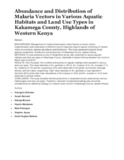Abundance and Distribution of Malaria Vectors in Various Aquatic Habitats and Land Use Types in Kakamega County, Highlands of Western
Date
2021-03-01Author
Kitungulu, Nicholas
Guyah, Bernard
Ndenga, Bryson
Mukabane, Kipcho
Kilongosi, Mark
Ayuya, Stephen
Mulama, David Hughes
Metadata
Show full item recordAbstract
BACKGROUND: Management of malaria transmission relies heavily on vector control. Implementation and sustenance of effective control measures require regular monitoring of malaria vector occurrences, species abundance and distribution. The study assessed mosquito larval species composition, distribution and productivity in Kakamega County, western Kenya.
METHODS: A cross-sectional survey of Anopheline larvae was conducted in various aquatic habitats and land use types in Kakamega County, highlands of western Kenya between the month of March and June 2019.
RESULTS: One thousand, five hundred and seventy six aquatic habitats were sampled in various land use types. The mean densities of An. gambiae s.l (46.2), An. funestus (5.3), An. coustani (1.7), An. implexus (0.13) and An. squamosus (2.0) were observed in fish ponds, burrow pits, drainage ditches, and tire tracks, respectively. High mean densities of An. gambiae s.l was reported in farmland (20.4) while high mean abundance of An.funestus s.l (8.2) and An. coustani s.l (4.0) were observed in artificial forests.
CONCLUSION: The study revealed that the productivity of anopheles larvae varied across various habitat types and land use types. Therefore, treatment of potential breeding sites should be considered as an additional strategy for malaria vector control in Kakamega County, western Kenya.
URI
https://doi.org/10.4314/ejhs.v31i2.7https://www.ajol.info/index.php/ejhs/article/view/206822
http://ir-library.mmust.ac.ke:8080/xmlui/handle/123456789/1919
Collections
- Gold Collection [1026]

